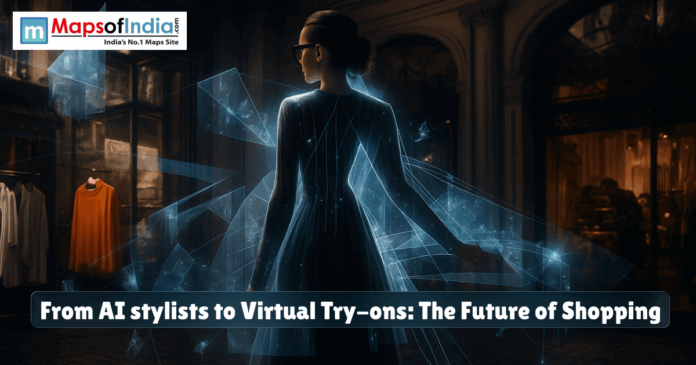The shopping experience in the last ten years has changed so that instead of malls and stores, we go to a tap and a scroll. However, the following retail chapter is not all about convenience; it is about being smart, personal, and immersive. And as the time of AI stylists and virtual try-on clothing comes with it, we are entering the future where fashion and technology become combined to such a degree that we will make even smarter, faster and more pleasant shopping experiences possible.
The Shift Towards Smart Shopping
The old e-marketplaces were quite suited to browsing through the product, yet they tended to involve no human approach. People had no chance to touch the material, see the fit, or observe how a pair of sunglasses would fit their face. This brought forth a disparity between online and retail buying.
Enter augmented reality and artificial intelligence. All these technologies are changing the way people associate themselves with the products and brands. The machine learning algorithms now study the preferences of users, their figures, and their online purchases and recommend custom outfits. Virtual try-on products developed based on AR allow customers to see the ways the clothes, shoes, makeup, or any accessories suit them before making a purchase. It is no longer just shopping, but nowadays it is a personalized, interactive process.
Meet Your AI Stylist
Just imagine you enter a digital store, and a personal stylist meets you, trying to know what mood you are in, what you are approaching this store, what colors you like, and he/she even asks you about your favorite fashion figures. This stylist is not a human being, though; it is AI.
Machine learning aims to gather information about your sense of style by examining your past behavioral data, including what you buy and what you visit in your shopping, and even your social media profile. Such companies as Stitch Fix, The Yes and Amazon Fashion are already using AI-powered personalized recommendations. Such systems select wardrobes depending on the trends, body type, seasons, and customer reviews.
The real revolution of AI stylists is that they learn. The more you engage with them, the more they will know your taste in fashion. As time goes by, their suggestions are more accurate, more refined, and quite creepily precise. It is as good as having a best friend who understands your wardrobe more than you do.
Virtual Try-Ons: Try Before You Buy, Digitally
The inability to determine fit or looks in online shopping is probably one of the greatest shortcomings of the online shopping phenomenon. Does that dress fit my complexion? Are these glasses on my face? Is this foundation tone suitable for me?
Including augmented reality and computer vision, this problem is solved by the technology of virtual try-on. You will be able to feel what it is like to wear an outfit, a pair of shoes, makeup, or accessories: all you need to do is use your phone or webcam and interactively put it on right at your couch. You can see what the product would be like on you, how it will flow with your shape and your measurements.
Such giant retailers as Lenskart, Warby Parker, Sephora, and Zara have already implemented the concept of the virtual try-on into the application and in web services. Lenskart allows you to wear various frames on your face by means of 3D scanning. Sephora AR mirror demonstrates the effect of lipsticks and eyeliners of different shades on your skin color. Nike allows one to see the sneakers in all directions, in order to choose the working size and model.
The result? The significant decrease in returns and a more secure and pleasant shopping experience.
Smart Mirrors and AR Fitting Rooms
The physical stores are not left behind. They are changing as well, with technology. Smart mirrors & AR fitting rooms are going to become a trend in luxury retailers and flagship stores.
These mirrors are virtual screens which allow the customers to see what outfits, colors, or styles suit them, even though they do not have to change clothes. It is possible to take a position in front of a high-tech mirror, select a dress on the screen and visualize its presence on oneself in real-time. Some of the mirrors are even voice or gesture-controlled control turning the shopping process into an interactive one.
H&M, Ralph Lauren and Rebecca Minkoff have introduced intelligent fitting rooms where people are offered accessories and supplementary clothes, and a trial turns out to be a fashion consultation.
How AI Predicts What You’ll Want Next
The other retail game-changer is predictive analytics. AI not only reacts to what you need; it predicts it. With your browsing and purchasing habits, AI can recommend what you need next even before you want to search for it.
Suppose that you have just purchased some running shoes. AI could recommend sports apparel, exercise tracker, protein powder, etc., anything that would fit well with your new lifestyle. Such predictive behavior increases cross-selling and client satisfaction at the same time.
Additionally, AI assists retailers in keeping their inventory at a good level by predicting activity and consumer demand. What this implies is that there will be fewer out-of-stock products, more suitable assortments, and quicker deliveries.
The Role of Data and Personalization
All of this retail revolution is centred on one thing: data, and lots of it. Every like, swipe and share is sold to algorithms that crack your preferences and behavior. On one hand, the threat of having the knowledge of all the experience of a person is cause of a valid privacy objection. Hyper-personalization on the other hand is enabled by this power.
Personalized shopping does not only imply referring to clothes that fit your size. Instead, it can adapt visuals of models to your figure, advise sizes depending on returns in the past, or even suggest outfits that fit your current collection.
The retailers are now also shifting into what is termed as a kind of personalized pricing, i.e. discounts to their customers according to their loyalty or frequency of visiting the stores or even due to local events. The more you tell the brands about yourself (no privacy compromise though) morally and with contractual permissions, the better you will be served.
Challenges and Considerations
It is all quite interesting in the future of shopping but it also poses complications. The issue of data privacy comes up in order. The question of ethical use of personal data collected by brands is becoming even more important as the brands amass an increasing amount of personal data.
One would also face the danger of excessive automation dependence. Not all customers desire a robotic experience; some of them still desire the human contact, the feel, and the spontaneity.
In addition, the issue of access to technology is a setback. In some areas, luxury AR functionalities or intelligent mirrors might not be ready or cost-effective for every company. Inclusivity is an essential element in this digital revolution.
Conclusion
The way we shop is already being revolutionized before our eyes, all the way from the AI-driven stylists to the virtual tries. No, it is not really about spending, but it is about being recognized, comprehended, and feeling strong during the process. With further developments of technology, our associations with fashion and commerce would continue to change.
This new world means that the outfit that you were going to get next may not be the sultry one you see in the window at the mall; instead, it may be at the bottom of your algorithm.




